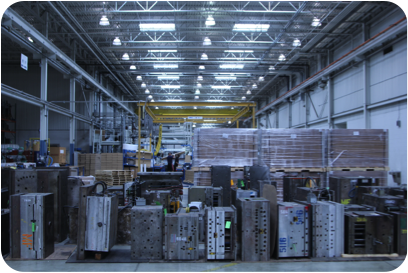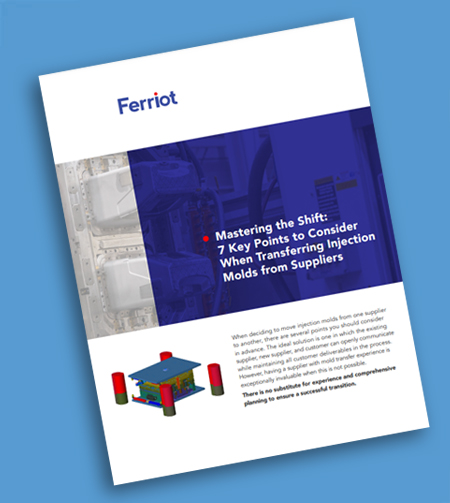 Several points should be taken into consideration when deciding to move injection molds from one supplier to another. The ideal solution is one in which the existing supplier, new supplier and customer are able to openly communicate while maintaining all customer deliverables in the process. However, when this is not possible, having a supplier that has experience with this type of transaction is extremely invaluable. There is no substitute for experience and comprehensive planning.
Several points should be taken into consideration when deciding to move injection molds from one supplier to another. The ideal solution is one in which the existing supplier, new supplier and customer are able to openly communicate while maintaining all customer deliverables in the process. However, when this is not possible, having a supplier that has experience with this type of transaction is extremely invaluable. There is no substitute for experience and comprehensive planning.
The following Mold Transfer Guidelines provide key points to consider when transferring molds:
1: Establish a sufficient buffer of inventory prior to transferring the business.
This will cover the time necessary for the new supplier to put the essential provisions in place to transact future business uninterrupted. If the buffer is too small, it will put undue pressure on all parties, requiring alternative plans without sufficient time to execute.
Ample time should be given to:
Current Supplier/Customer
- Wind down remaining open orders.
- Collect and inventory all customer-specific information and property (inclusive of molds, unique raw materials not consumed in fulfilling remaining open orders, special gages, fixtures, equipment, updated mold designs reflecting the current part revision level, product and process qualification information, mold maintenance records, past and present quality concerns, etc.)
- Make sure all assets are identified, tagged and recorded based on associated part numbers.
- Photograph all assets.
- Palletize and ship customer property to the new supplier.
New Supplier
- Receive, de-palletize, inspect and clean (if needed) customer property. Verify and record that all customer property has been received and nothing has been damaged in transit.
- Evaluate and document mold wear.
- Develop a preliminary preventative mold maintenance schedule.
- Verify that all molds will properly adapt to the equipment they will be running in.
- Procure needed raw materials, specialty tooling and equipment.
- Develop and complete DOE’s, control plans, process FMEA’s, work instructions, first article inspections, capability studies of control dimensions and Gauge R & R studies.
- Qualify the molds/parts being transferred.
- Receive final part approval from the customer prior to production start-up.
2: Obtain clear deliverables from the customer in terms of Quality, Delivery, Service and Costs.
Both the new supplier and the customer should be on the same page as to what the expected deliverables are. This will establish the basic foundation from which the future relationship will be measured.
3: Establish key lines of communication between the new supplier and the customer.
Key contacts should be made in the areas of Quality, Engineering, Manufacturing, Purchasing and Customer Service. This will streamline communications and insure the proper parties are aware of key deliverables.
4: Establish visual cosmetic standards for all parts.
It’s best to create boundary samples to avoid interpretation errors later on. The goal is to eliminate subjectivity as much as possible on both sides (supplier and customer).
If possible, retain the last “acceptable” shot (part and runner attached if applicable) off of each mold prior to transferring. This visual sample will provide key information to the new supplier in terms of current mold condition and customer acceptance standards. Preferably, parts should be untouched as they are molded prior to any secondary operations. This last shot should be inspected by the new supplier and matched against the customer’s current quality acceptance standards for conformance (i.e. all notes, dimensions and cosmetic attributes). Noted deviations will require customer disposition to assure all acceptance documentation matches the approved customer signed off “golden” sample.
5: Customer to clearly identify and communicate all known problems to the new supplier.
Full disclosure is essential in meeting short and long-term goals. This should include past history as well as current status.
Jointly develop an action plan to resolve outstanding problems in accordance with future production needs and in order of importance. This will provide a successful foundation on which to build on.
For another post related to injection molding, check out:
7 Aspects to Identify When Designing Injection Molded Plastic Parts




